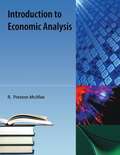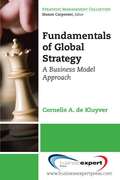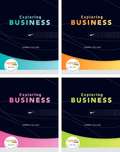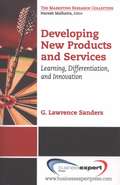Special Collections
Free Upskilling Books for All!
- Table View
- List View
Introduction to the Law of Property, Estate Planning, and Insurance
by Don Mayer and Daniel M. Warner and George J. Siedel and Jethro K. LiebermanMayer, Warner, Siedel and Lieberman's Introduction to the Law of Property, Estate Planning and Insurance is an up-to-date textbook that covers legal issues that students must understand relating to real estate (an especially important business asset), as well as estate planning and insurance. The text is organized to permit instructors to tailor the materials to their particular approach. The authors take special care to engage students by relating law to everyday events with their clear, concise and readable style. After introductory chapters covering the legal environment of business, Introduction to the Law of Property, Estate Planning and Insurance provides students with context and essential legal concepts relating to property rights and duties, estate planning, insurance, secured transactions, mortgages, and related topics. The text provides the vocabulary and legal savvy they will need when working with these concepts, which are critical to business planning and success. With Introduction to the Law of Property, Estate Planning and Insurance, the authors have created a text that not only has both case summaries and excerpted cases, but one that you can easily customize by deleting chapters, reordering the content, adding your own material, and even editing at the line level with Flat World's easy-to-use MIYO (Make It Your Own) Platform. The free online version of the text includes embedded links to law-related videos at YouTube and other online sites for easy access by students and instructors.
Introduction to Psychology
by Charles StangorWhen you teach Introduction to Psychology, do you find it difficult — much harder than teaching classes in statistics or research methods? Do you easily give a lecture on the sympathetic nervous system, a lecture on Piaget, and a lecture on social cognition, but struggle with linking these topics together for the student? Do you feel like you are presenting a laundry list of research findings rather than an integrated set of principles and knowledge? Have you wondered how to ensure your course is relevant to your students? If so, then you have something in common with Charles Stangor. Charles Stangor's Introduction to Psychology utilizes the dual theme of behavior and empiricism to make psychology relevant to intro students. Charles wrote this book to help students organize their thinking about psychology at a conceptual level. Five or ten years from now, he does not expect his students to remember the details of most of what he teaches them.
Introduction to Economic Analysis
by R. Preston Mcafee and Tracy R. LewisThis book presents standard intermediate microeconomics material and some material that, in the authors' view, ought to be standard but is not. Introductory economics material is integrated. Standard mathematical tools, including calculus, are used throughout. The book easily serves as an intermediate microeconomics text, and can be used for a relatively sophisticated undergraduate who has not taken a basic university course in economics. The focus of this book is on the conceptual tools and not on fluff. As such, it reflects the approach actually adopted by the majority of economists for understanding economic activity. There are lots of models and equations, and no pictures of economists ;-) Economic analysis is used in many situations. When British Petroleum sets the price for Alaskan crude oil, it uses an estimated demand model, both for gasoline consumers and also for the refineries to which BP sells. Economic analysis was used by experts in the antitrust suit brought by the U.S. Department of Justice both to understand Microsoft s incentive to foreclose (eliminate from the market) rival Netscape and consumer behavior in the face of alleged foreclosure. Stock market analysts use economic models to forecast the profits of companies to predict the price of their stocks. When the government forecasts the budget deficit or considers a change in environmental regulations, it uses economic models. This book presents the building blocks of the models in common use by an army of economists thousands of times per day. This book, plus econometrics, provides most of the economic analysis tools to take upper division economics courses of any type.
Introduction to Contracts, Sales and Product Liability
by Don Mayer and Daniel M. Warner and George J. Siedel and Jethro K. LiebermanMayer, Warner, Siedel and Lieberman's Introduction to Contracts, Sales and Product Liability is an up-to-date textbook that includes legal issues that are covered in an introductory business law course. The text is organized to permit instructors to tailor the materials to their particular approach. The authors take special care to engage students by relating law to everyday events with their clear, concise and readable style.
International Finance
by Steve SuranovicInternational Finance Theory and Policy is built on Steve Suranovic's belief that to understand the international economy, students need to learn how economic models are applied to real world problems. It is true what they say, that "economists do it with models." That's because economic models provide insights about the world that are simply not obtainable solely by discussion of the issues. International Finance Theory and Policy develops a unified model of the international macroeconomy. The text provides detailed descriptions of major macroeconomic variables, covers the interest rate parity and purchasing power parity theories of exchange rate determination, takes an exhaustive look at the pros and cons of trade imbalances and presents the well-known AA-DD model to explore the effects of fiscal and monetary policy under both fixed and flexible exchange rates. The models are developed, not by employing advanced mathematics, but rather by walking students through a detailed description of how a model's assumptions influence its conclusions. But more importantly, each model and theory is connected to real world policy issues. The Finance Text has the following unique features: o Begins with an historical overview of the international macroeconomy to provide context for the theory. o Concludes with a detailed discussion of the pros and cons of fixed and floating exchange rate systems. o Provides an extensive look at the issue of trade imbalances. Readers learn techniques to evaluate whether a country's trade deficit (or surplus) is dangerous, beneficial, or benign. o Explains how purchasing power parity is used to make cross country income comparisons. o Offers clear detailed explanations of the AA-DD model. o Applies the AA-DD model to understand the effects of monetary and fiscal policy on GDP, the exchange rate, and the trade balance.
International Business
by Mason A. Carpenter and Sanjyot P. DunungInternational Business is one of the most challenging and exciting courses to teach in the Business School. To teach a current, dynamic and complete course you need a textbook by authors as passionate and informed about International Business as you are. Carpenter and Dunung's International Business: The Opportunities and Challenges of a Flat World provides exploration into building, leading, and thriving in global organizations in an increasingly flat world. The authors define "Flat world" as one where (1) service industries that dwarf manufacturing industries in terms of scale and scope, (2) an Internet that pervades life and work, and (3) networks define modern businesses, whether service or manufacturing. Carpenter and Dunung's text is designed to speak to technologically-savvy students who see national borders as bridges and not barriers. The authors use the lexicon of international business, and additionally, develop students' knowledge of international contexts with the aim that they may launch, run, and work in any organization that is global in scope (or is wrestling with global competition or other global threats).
Intermediate Algebra
by John ReddenIt is essential to lay a solid foundation in mathematics if a student is to be competitive in today's global market. The importance of algebra, in particular, cannot be overstated, as it is the basis of all mathematical modeling used in applications found in all disciplines. Traditionally, the study of algebra is separated into a two parts, Elementary and Intermediate Algebra. This textbook by John Redden, Intermediate Algebra, is the second part. Written in a clear and concise manner, it carefully builds on the basics learned in Elementary Algebra and introduces the more advanced topics required for further study in applications found in most disciplines. Used as a standalone textbook, Intermediate Algebra offers plenty of review as well as something new to engage the student in each chapter. Written as a blend of the traditional and graphical approaches to the subject, this textbook introduces functions early and stresses the geometry behind the algebra. While CAS independent, a standard scientific calculator will be required and further research using technology is encouraged.
Information Systems
by John GallaugherInformation Systems: A Manager’s Guide to Harnessing Technology V 1.4 is intended for use in undergraduate and/or graduate courses in Management Information Systems and Information Technology. Version 1.4 of John's book retains the same structure and theory of the earlier versions, but Version 1.4 updates key statistics and examples, and includes up-to-date case material, such as Pinterest and Facebook’s Instagram acquisition. Adopting version 1.4 guarantees your students will have the most current text on the market, drawing real and applicable lessons from material that will keep your class offerings current and accessible.
Human Resource Management
by Laura Portolese DiasHuman Resource Management by Laura Portolese Dias teaches HRM strategies and theories that any manager--not just those in HR--needs to know about recruiting, selecting, training, and compensating people. Most students will be managing people at some point in their careers and not necessarily in a human resource management capacity. As businesses cut back, they may outsource HR duties to outside vendors. Or, in smaller businesses, the HR department is sometimes small or non-existent, and managers from other departments have to perform their own HRM. Therefore, teaching HRM from the perspective of a general manager, in addition to an HR manager, provides more relevance to students' careers and will give them a competitive advantage in the workplace.
Human Relations
by Laura Portolese DiasHuman Relations by Laura Portolese-Dias addresses all of the critical topics to obtain career success as they relate to professional relationships. Knowing how to get along with others, resolve workplace conflict, manage relationships, communicate well, and make good decisions are all critical skills all students need to succeed in career and in life. Human Relations book isn't an organizational behavior text, but it provides a good baseline of issues students will deal with in their careers on a day-to-day basis. This book is also not a professional communications book, business English, or professionalism book, as the focus is much broader--on general career success and how to effectively maneuver in the workplace.
How to Use Microsoft® Excel®
by Joseph M. ManzoHow to Use Microsoft® Excel® The Careers in Practice Series is an textbook appropriate for a course covering Microsoft Excel at a beginner to intermediate level. It is geared toward and will be accommodating for students and instructors with little to no experience in using Microsoft Excel. However, the approach is not at the expense of relevance. How to Use Microsoft® Excel® The Careers in Practice Series approaches Excel from the perspective of making personal and professional quantitative decisions. Personal decisions include big purchases such as homes and automobiles, savings for retirement, and personal budgets. Professional decisions include budgets for managing expenses, merchandise items to markdown or discontinue, and inventory management.
Government Regulation and the Legal Environment of Business
by Don Mayer and Daniel M. Warner and George J. Siedel and Jethro K. LiebermanMayer, Warner, Siedel and Lieberman's Government Regulation and the Legal Environment of Business is an up-to-date textbook that covers legal issues that students must understand in today’s highly regulated business environment. The text is organized to permit instructors to tailor the materials to their particular approach. The authors take special care to engage students by relating law to everyday events with their clear, concise and readable style.
General Chemistry
by Bruce Averill and Patricia EldredgeThe overall goal of the authors with General Chemistry: Principles, Patterns, and Applications was to produce a text that introduces the students to the relevance and excitement of chemistry. Although much of first-year chemistry is taught as a service course, Bruce and Patricia feel there is no reason that the intrinsic excitement and potential of chemistry cannot be the focal point of the text and the course. So, they emphasize the positive aspects of chemistry and its relationship to students' lives, which requires bringing in applications early and often. In addition, the authors feel that many first year chemistry students have an enthusiasm for biologically and medically relevant topics, so they use an integrated approach in their text that includes explicit discussions of biological and environmental applications of chemistry. Topics relevant to materials science are also introduced to meet the more specific needs of engineering students.
General Chemistry
by Bruce Averill and Patricia EldredgeThe overall goal of the authors with General Chemistry: Principles, Patterns, and Applications was to produce a text that introduces the students to the relevance and excitement of chemistry. Although much of first-year chemistry is taught as a service course, Bruce and Patricia feel there is no reason that the intrinsic excitement and potential of chemistry cannot be the focal point of the text and the course. So, they emphasize the positive aspects of chemistry and its relationship to students’ lives, which requires bringing in applications early and often. In addition, the authors feel that many first year chemistry students have an enthusiasm for biologically and medically relevant topics, so they use an integrated approach in their text that includes explicit discussions of biological and environmental applications of chemistry. Topics relevant to materials science are also introduced to meet the more specific needs of engineering students.
Fundamentals of Global Strategy
by Cornelis A. de KluyverThis book looks at the opportunities and risks associated with staking out a global competitive presence and introduces the fundamentals of global strategic thinking. We define crafting a global strategy in terms of change: how a company should change and adapt its core (domestic) business model to achieve a competitive advantage as it expands globally. The conceptual framework behind this definition has three fundamental building blocks: a company's core business model, the various strategic decisions a company needs to make as it globalizes its operations, and a range of globalization strategies for creating a global competitive advantage. A business model is defined in terms of four principal components: (a) market participation--who its customers are, how it reaches them and relates to them; (b) the value proposition--what a company offers its customers; (c) the supply chain infrastructure--with what resources, activities and partners it creates its offerings; and finally, (d) its management model--how it organizes and coordinates its operations. Globalization requires a company to make strategic decisions about each component of the business model. Market participation decisions include choosing which specific markets or segments to serve, domestically or abroad; what methods of distribution to use to reach target customers; and how to promote and advertise the value proposition. Globalization decisions about the value proposition touch the full range of tangible and intangible benefits a company provides to its customers (stakeholders). Decisions about a company's value chain infrastructure deal with such questions as, What key internal resources and capabilities has the company created to support the chosen value proposition and target markets? What partner network has it assembled to support the business model? How are these activities organized into an overall, coherent value creation and delivery model? Finally, strategic decisions about the global management dimension are concerned with a company's choices about a suitable global organizational structure and decision-making process. We use Pankaj Ghemawat's well-known "AAA Triangle" framework to define three generic approaches to global value creation. Adaptation strategies seek to increase revenues and market share by tailoring one or more components of a company's business model to suit local requirements or preferences. Aggregation strategies focus on achieving economies of scale or scope by creating regional or global efficiencies; they typically involve standardizing a significant portion of the value proposition and grouping together development and production processes. Arbitrage is about exploiting economic or other differences between national or regional markets, usually by locating separate parts of the supply chain in different places.
Foundations of Business Law and the Legal Environment
by Don Mayer and Daniel M. Warner and George J. Siedel and Jethro K. LiebermanMayer, Warner, Siedel and Lieberman's Foundations of Business Law and the Legal Environment is an up-to-date textbook with comprehensive coverage of legal and regulatory issues for your introductory Legal Environment or Business Law course. The text is organized to permit instructors to tailor the materials to their particular approach. The authors take special care to engage students by relating law to everyday events with which they are already familiar with their clear, concise and readable style. Business Law and the Legal Environment provides students with context and essential concepts across a broad range of legal issues with which managers and business executives must grapple. The text provides the vocabulary and legal savvy necessary for business people to talk in an educated way to their customers, employees, suppliers, government officials -- and to their own lawyers. With Foundations of Business Law and the Legal Environment, the authors have created a text that not only has both case summaries and excerpted cases, but one that you can easily customize by deleting chapters, reordering the content, adding your own material, and even editing at the line level with Flat World's easy-to-use MIYO (Make It Your Own) Platform.
Focusing on Organizational Change
by William Q. Judge Jr.Never before have strategic leaders been confronted with so much overwhelming change. The traditional approach taken by the leader or leaders is to direct or control the organization's reaction on a monthly, weekly, or even daily basis. This approach is stressful and overwhelming for executive leaders, makes middle managers feel torn between honoring their senior leaders and listening to the demands of frontline employees, and is alienating for frontline employees. This approach is hardly a prescription for the pursuit of excellence, and does not enable the organization to be sufficiently agile or nimble to cope with the "white water" conditions in which the organization typically finds itself. This book offers an alternative to the traditional approach by focusing on building the change capacity of the entire organization in anticipation of future pressures to change. An organization's capacity for change is an eight-dimensional dynamic capability of an organization or organizational unit to successfully adapt to the changing organization-environment interface. In change-capable organizations, the strategic leader's role is more of an architect or designer of the organization in anticipation of oncoming change, rather than a commander or controller reacting to change. This approach unleashes the organization's creative potential while maintaining accountability, clarifies the roles of each and every employee in the change process while enhancing organizational flexibility, aligns organizational systems to facilitate change, and builds the organization's leadership pipeline for the future. Based on systematic research of more than 5,000 respondents working within more than 200 organization or organizational units conducted during the previous decade, this book offers a clear and proven method for diagnosing your organizational change capacity. Building on my previous consulting experience and anecdotal evidence, you will also learn how to enhance your organization's change capacity. While building organizational change capacity is not fast or easy, it is essential for effective leadership and organizational survival in the 21st century. This book provides guidance on how to do that essential work in the new millennium.
Financial Accounting
by Joe Ben Hoyle and C. J. SkenderThis book is suitable for an undergraduate or MBA level Financial Accounting course. If authorship matters (and we believe it is everything) then this book is destined to be a classic. There are no two better authors than these. Joe Ben Hoyle is co-author of two current market-leading advanced accounting textbooks with McGraw-Hill. He and and co-author CJ Skender are nationally recognized as master teachers. Both have won numerous teaching awards, and both were recently recognized by BusinessWeek as top undergraduate professors. The authors bring their collective teaching wisdom to bear in this book not by changing "the message"(financial accounting content), but by changing "the messenger" (the way the content is presented). The approach centers around utilizing the Socratic method, or simply put, asking and answering questions. The reason that this approach continues to be glorified after thousands of years is simple - it engages students and stresses understanding over memorization. So this text covers standard topics in a standard sequence, but does so through asking a carefully constructed series of questions along with their individual answers.
Exploring Perspectives
by Randall FallowsThis 5 chapter primer will help give students a better understanding of how to discover, develop, and revise an analytical essay for their argument and persuasion courses.
Exploring Business
by Karen CollinsCollins is the only Introduction to Business book to teach students the topics of business through an in-depth study of a single company--Nike. How do you show your students the relationships between what they are learning in the classroom and what happens in the real business world? What happens when your students don't see the connections between the theory they are learning in the classroom and what is happening in the real business world?
Essentials of Nutrition
by Maureen Zimmerman and Beth SnowEssentials of Nutrition: A Functional Approach, by Zimmerman and Snow is a textbook aimed at non-majors for the nutrition course. With this text your students will examine some of the popular myths about nutrition and will develop a foundation for making smart dietary choices and to debunk these common nutrition myths. As students learn about the role of nutrition in optimal health, they will learn about dietary nutrients and toxicants. A sampling of topics covered include macro- and micronutrient needs; determining individual nutrient and caloric needs; digestion and absorption; nutritional needs throughout the various stages of human development; and current food issues, sustainability concerns, including food safety.
Essentials of Geographic Information Systems
by Jonathan Campbell and Michael ShinEssentials of Geographic Information Systems integrates key concepts behind the technology with practical concerns and real-world applications. Recognizing that many potential GIS users are non-specialists or may only need a few maps, this book is designed to be accessible, pragmatic and concise. Essentials of Geographic Information Systems also illustrates how GIS is used to ask questions, inform choices and guide policy. From the melting of the polar ice caps to privacy issues associated with mapping, this book provides a gentle, yet substantive, introduction to the use and application of digital maps, mapping and GIS.
eMarketing
by Rob Stokes and the Minds of QuirkeMarketing: The Essential Guide to Online Marketing by Rob Stokes, a marketing guru and CEO of Quirk eMarketing, Sarah Blake, and his team of QuirkStars, consolidates 11 years of real marketing experience doing online marketing at Quirk into a full length textbook that draws on both academic theory and practical experience. It is intended for third and fourth year marketing students, this textbook covers all of the important aspects of online marketing, including chapters on each of the following areas: * Search Engine Marketing * Affiliate Marketing * Web Analytics and Conversion Optimisation * Web Development * Online Copywriting * Online Advertising * WebPR * Online Reputation Management * Pay Per Click Advertising * Viral Marketing * Social Media Marketing * Search Engine Optimisation * eMarketing Strategy * Market Research * Mobile Marketing * Crowdsourcing * Customer Relationship Management It also features a glossary and index as well as summaries, learning objectives and discussion points for each chapter. This eMarketing textbook offers students information that is highly applicable with examples to which they can easily relate. It is a must-have guide for each and every undergraduate and post-graduate marketing student as well as anyone working in the digital or traditional marketing sphere.
Elementary Algebra
by John ReddenIt is essential to lay a solid foundation in mathematics if a student is to be competitive in today's global market. The importance of algebra, in particular, cannot be overstated as it is the basis of all mathematical modeling used in applications found in all disciplines. Traditionally, the study of algebra is separated into a two parts, Elementary and Intermediate Algebra. This textbook by John Redden, Elementary Algebra, is the first part written in a clear and concise manner, making no assumption of prior algebra experience. It carefully guides students from the basics to the more advanced techniques required to be successful in the next course.
Developing New Products and Services
by G. Lawrence SandersThe focus of the book is on the up-front activities and ideas for new product and service development. A central theme of this book is that there is, or should be, a constant struggle going on in every organization, business, and system between delivering feature-rich versions of products and services using extravagant engineering and delivering low-cost versions of products and services using frugal engineering. Delivering innovative products is accomplished by an endless cycle of business planning, creative and innovative insight, and learning-about and learning-by-doing activities. A number of powerful concepts and tools are presented in the book to facilitate new product development. For example, three templates are presented that facilitate new product and service development. The FAD (features, attributes, and design) template is used to identify the features and attributes that can be used for product and service differentiation. The Ten-Ten planning process contains two templates: an Organizational and Industry Analysis template and the Business Plan Overview template. These two templates coupled with the FAD template can be used to develop a full-blown business plan. Entrepreneurship, technology and product life cycles, product and service versioning, product line optimization, creativity, lock-in real options, business valuation, and project management topics are also covered.





